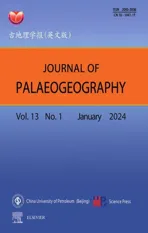A synthesis of the Cretaceous wildfire record related to atmospheric oxygen levels?
2024-01-25WeiWenXuDuZhiHuiZhngYunGoTinTinWngJinChengXuAoCongZhngChengShnWng
D-Wei Lü , Wen-Xu Du , Zhi-Hui Zhng ,*, Yun Go ,Tin-Tin Wng , Jin-Cheng Xu , Ao-Cong Zhng ,Cheng-Shn Wng
a Shandong Provincial Key Laboratory of Depositional Mineralization and Sedimentary Minerals, College of Earth Sciences and Engineering, Shandong University of Science and Technology, Qingdao 266590,Shandong Province, China
b School of Earth Sciences and Resources, China University of Geosciences, Beijing 100083, China
c Institute of Earth Sciences, China University of Geosciences (Beijing), Beijing 100083, China
Abstract The Cretaceous was a significant greenhouse period in Earth's history with higher atmospheric CO2 levels and temperatures than today.Although evidence of combustion has been widely described from the Cretaceous deposits, our understanding of the spatiotemporal diversification pattern and process of the Cretaceous wildfires is still limited.In this study, we comprehensively synthesize a total of 271 published Cretaceous wildfire occurrences based on the by-products of burning, including fossil charcoal, pyrogenic inertinite (fossil charcoal in coal), and pyrogenic polycyclic aromatic hydrocarbons (PAHs).Spatially, the dataset shows a distinctive distribution of reported wildfire evidence characterized by high concentration in the middle latitudinal areas of the Northern Hemisphere (30°N—60°N) over the Cretaceous.Temporally, an overall increasing trend of the reported wildfire data from the Early Cretaceous to the Late Cretaceous is coincident with higher atmospheric O2 levels.However, the spatial and temporal patterns may result from many types of factors,such as taphonomy,preservation,and researcher biases,instead of a real picture of the Cretaceous wildfire evolution.To better understand the spatiotemporal diversification of the Cretaceous wildfire,more investigations on the record of wildfire occurrences during this period would be necessary in the future.
Keywords Wildfire, Cretaceous, Atmospheric oxygen, Taphonomy, Charcoal
1.Introduction
As a common natural phenomenon, wildfire has been rapidly intensifying around the world due to global warming and climatic change today (Jones et al., 2020; Zhuang et al., 2021; Baker, 2022).Wildfires have occurred throughout Earth's history since the Silurian with the earliest discovery of charred plant fossils (Glasspool et al., 2004; Glasspool and Scott,2010; Glasspool and Gastaldo, 2022, 2023).Episodes of extensive wildfire activity have been identified in Earth's past based on variations in the by-products of combustion(Baker,2022).Wildfires can generate many products, including charcoal, soot, and pyrogenic polycyclic aromatic hydrocarbons (PAHs), that have the potential to be preserved in sediments (Scott,2000, 2010; Finkelstein et al., 2005).As a residual product of pyrolysis, charcoal is the direct proxy for studying wildfires in deep time (Scott, 2000, 2010).The typical charcoal fragments can be recognized according to the following criteria: opaque and black in color, lustrous shine with black streak, reflective of light,brittle fracture,and original anatomy preserved(Scott,2000,2010).Pyrogenic inertinite(i.e.,fusinite,semifusinite, and inertodetrinite) preserved in coal,lignite or peat is characterized by evident anatomical structures and high reflectance(ICCP,2001),which can be petrographically referred to as charcoal(Scott and Glasspool,2007;Glasspool and Scott,2010).The other effective evidence for wildfire comes from pyrogenic PAHs,which are widely distributed organic compounds(Killops and Massoud, 1992; Yunker et al., 2002).The pyrogenic PAHs, such as pyrene, benzofluoranthenes,benzo[e]pyrene, benzo[ghi]perylene, and coronene,are thought to have all been attributed to combustionderived sources (Nabbefeld et al., 2010; Shen et al.,2011).Soot from wildfires can spread globally, and the source of soot is not exclusively biomass burning,which makes a relatively small contribution to the identification of wildfire occurrence in the rock record,so it is not an accurate indicator of the exact location of wildfires (Belcher et al., 2003; Shen et al., 2011).Over geological timescales, variations in wildfire activity are controlled by global long-term processes,including atmospheric oxygen concentration (pO2),conducive climate with low moisture and an ignition mechanism, and fuel availability (load and state)(Scott,2000;Glasspool et al.,2015;Baker et al.,2017;Belcher and Hudspith, 2017;Baker,2022).
The Cretaceous is a significant period due to its high CO2and greenhouse climate(Spicer and Skelton,2003;Brentnall et al., 2005; Haworth et al., 2005).Many studies found that combustion products have been commonly preserved in the Cretaceous sedimentary systems (e.g., Friis and Skarby, 1981; Gomez et al.,2002; Glasspool and Scott, 2010; Mays et al., 2017;Wang et al.,2019,2021).Brown et al.(2012)reviewed and compiled global Cretaceous charcoal occurrences,showing that wildfires were widespread and frequent during the Cretaceous period which can be considered a“high-fire”world(Scott et al.,2014).In addition,some events of major climatic change in the Cretaceous(e.g.,Oceanic Anoxic Events)have been well-linked to periods of increased wildfire occurrences (e.g., Baker et al., 2020; Boudinot and Sepúlveda, 2020; Xu et al.,2022; Zhang et al., 2022a).Baker et al.(2020) and Boudinot and Sepúlveda (2020) identified that an increase in wildfire activity was found across the initiation and into the ‘early stage’ of the Cretaceous Oceanic Anoxic Event 2 (OAE2).Xu et al.(2022) and Zhang et al.(2022b)suggested that during the Oceanic Anoxic Event 1b(OAE1b)interval,high wildfire activity correlated with high nutrients and organic matter levels in lakes can contribute to eutrophication and anoxia in lacustrine and in contemporaneous oceanic systems.However, understanding of the temporal variation in wildfires during the Cretaceous is still limited (Brown et al.,2012;Jasper et al.,2021).
This study systematically synthesized global wildfire occurrences in the Cretaceous based on fossil charcoals and geochemical evidence from published literature.We also discussed possible controlling factors for changes in the reported Cretaceous wildfire data in time and space.
2.Materials and methods
To build a reliable database of the Cretaceous wildfires, we compiled data from publications in only peer-reviewed journals following the method of Lu et al.(2021).Unpublished data and personal materials were not included in our study.Specific keywords,i.e., ‘Cretaceous wildfire’, ‘charcoal’, ‘inertinite’,‘fusain’,‘fusinite’,and/or‘PAHs’were used to search articles in Google Scholar, Web of Science, Science-Direct and JSTOR for articles.All literature search was conducted by the end of May 2023.
To minimize the possibility of including lowquality/reliability of wildfire evidence, the published data in original articles were further checked and evaluated before being included in our database.The fossil charcoal evidence was recorded in our database based on the standardized guideline of Scott (2000,2010,2020).The PAHs have two types of origins,e.g.,petrogenic and pyrogenic (Yunker et al., 2002).Only data of pyrogenic PAHs in original publications were included in our database.Soot is also reported in articles cited in our database(e.g.,Synnott et al.,2021),but as soot does not indicate the location of a wildfire,we have not specifically studied it.
The original dataset of the Cretaceous charcoal and inertinite(charcoal in coal)occurrences(Brown et al.,2012) was incorporated for this study after excluding some data without convincing hard evidence for wildfire,e.g.,Troost(1821),Hollick(1906),and Hollick and Jeffrey (1909).Three types of Cretaceous wildfire evidence were recorded separately for our database:charcoal type I(fossil charcoal from clastic sediments),charcoal type II (pyrogenic inertinite from coals), and pyrogenic PAHs.For each occurrence, time, locality,latitude, longitude, paleolatitude, paleolongitude,stratigraphic unit (e.g., Formation, and Group), rock type (e.g., sandstone, mudstone, and coal), and reference were also recorded.In our database, when more than one literature recognized wildfire evidence from the same stratigraphic unit in the same site(e.g.,section, region, or basin), only one occurrence was scored.One item of literature may produce more than one occurrence from different stratigraphic units,excluding review articles that do not present new occurrences.When both fossil charcoal and pyrogenic PAHs data were reported from the same stratigraphic unit,we only scored one occurrence.
The Cretaceous period (145—66 Ma) was subgrouped into 12 time-bins according to stage boundaries(Gradstein and Ogg,2020)(Supplementary Table S1).The wildfire occurrences were assigned into the 12 time-bins based on the age data in the original literature.To avoid incorrect scoring for wildfire occurrences, the age data of the original stratigraphic unit were verified on the most recent dates.In continental sedimentary deposits, in some cases it is difficult to provide precise age data.When wildfire evidence was collected across more than one time-bin, the wildfire occurrence was assigned to all covered time-bins.
The data of paleolatitude and paleolongitude for each wildfire occurrence were estimated using GPlates 2.2.0 with the tectonic model of Scotese (2008).To show the geographic distribution of wildfire occurrence, 12 Cretaceous paleogeographic maps by Scotese (2016) were used.
3.Results
3.1.Cretaceous wildfire record in the geological context
A total of 271 published wildfire occurrences during the Cretaceous period have been compiled in this study (Supplementary Table S1).These occurrences can be grouped into six types of wildfire evidence,including 130 charcoal type I (48% in the total), 76 charcoal type II(28%),30 pyrogenic PAHs(11.1%),3 cooccurrences of charcoal type II and pyrogenic PAHs(1.1%), 28 co-occurrences of charcoal type I and pyrogenic PAHs (10.3%), and four co-occurrences of charcoal type I and charcoal type II (1.5%).
Published data for Cretaceous wildfires are from 142 stratigraphic units, of which 17 were from unspecified units.Of the total 271 reported wildfire occurrences, 263 entries were reported from clastic rock-dominant stratigraphic units including sandstone, siltstone, mudstone, marlstone, shale, and coal,six from limestone layers,one from the tuff,and one from an unknown rock type due to the unavailability of information in the original article(Supplementary Table S1).
3.2.Cretaceous wildfire occurrences in time
Of the 271 published wildfire occurrences,115 and 156 were recorded in the Early Cretaceous and the Late Cretaceous, respectively (Fig.1; Supplementary Table S1).The early Early Cretaceous (Berriasian to Hauterivian)had fewer reported wildfire occurrences,i.e.,8 for the Berriasian,12 for the Valanginian,and 10 for the Hauterivian.The late Early Cretaceous (Barremian to Albian) displayed an increasing trend of reported wildfire evidence,i.e.,11 for the Barremian,28 for the Aptian, and 46 for the Albian (Fig.1).Especially,the Albian shows evidence of a considerably high number of reported wildfires throughout the Cretaceous.The early Late Cretaceous has data for 66 reported wildfire occurrences(28 for the Cenomanian,23 for the Turonian, and 15 for the Coniacian), which are lower than those of the late Early Cretaceous.The late Late Cretaceous (Santonian to Maastrichtian)showed a similarly high value as the late Early Cretaceous, including 24 for the Santonian, 29 for the Campanian, and 37 for the Maastrichtian.
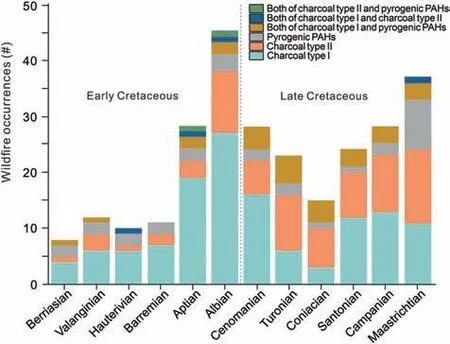
Fig.1 A total of 271 published wildfire occurrences in the 12 timebins of the Cretaceous, which are divided into six types, i.e.,charcoal type I (fossil charcoal from clastic sediments), charcoal type II (pyrogenic inertinite from coals), pyrogenic PAHs, cooccurrences of charcoal type II and pyrogenic PAHs, cooccurrences of charcoal type I and pyrogenic PAHs, and cooccurrences of charcoal type I and charcoal type II.The dotted line is the boundary between the Early and Late Cretaceous.

Fig.2 Overview of the published Cretaceous wildfire record.A)Wildfire occurrences in the Northern Hemisphere and Southern Hemisphere;B)Wildfire occurrences in five climatic zones of cool temperate,warm temperate,tropical,arid,and boreotropical,respectively.The dotted line is the boundary between the Early and the Late Cretaceous.
3.3.Cretaceous wildfire occurrences in space
Of the 271 reported Cretaceous wildfire occurrences, 199 were recorded from the Northern Hemisphere, and only 72 were distributed in the Southern Hemisphere(Fig.2A)during the Cretaceous.In the 12 time-bins, the published wildfire occurrences mainly occurred in the Northern Hemisphere ranging from 58.3% at the Valanginian to 82.1% at the Aptian and Cenomanian with an average of 71.9%.
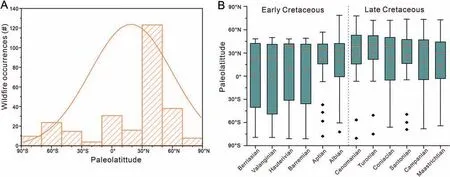
Fig.3 A) Published Cretaceous wildfire occurrences relative to paleolatitudes; B) Paleolatitudinal variation in published wildfire data over the Cretaceous period.Red hollow squares, red short lines and black solid diamonds represent mean, median, and outliers of the data,respectively.The dotted line is the boundary between the Early and the Late Cretaceous.
Based on the paleolatitude-based occurrences,the published Cretaceous wildfire evidence was mainly recorded in a middle latitude interval(30°N to 60°N)of the Northern Hemisphere (Fig.3).Throughout the 12 time-bins, the latitudinal distribution of wildfire occurrence was relatively stable between 30°N and 60°N, except for some Southern Hemisphere wildfires that were found in the Berriasian, Valanginian, Hauterivian, and Barremian (Fig.3).
Based on the paleoclimate classification proposed by Boucot et al.(2013), the Cretaceous period was characterized by five distinct paleoclimatic zones:cool temperate, warm temperate, boreotropical,tropical, and arid.The Cretaceous wildfire evidence was mainly found and published so far in the boreotropical zone (38% in the total) and warm temperate zone(38%).11.1%,8.8%,and 4.1%of reported wildfire occurrences were distributed in the tropical,arid,and cool zones, respectively.In the 12 time-bins, the reported wildfire occurrences mainly occurred in the warm temperate and boreotropical zones ranging from 62.5% at the Berriasian to 82.6% at the Turonian with an average of 74.6% (Fig.2B).
4.Discussion
4.1.Analytical biases and sampling variations
In this study, the global Cretaceous wildfire occurrences from published data show distinctive paleogeographic and stratigraphic distribution during the 12 time-bins.The reported wildfire evidence was distributed in a scattered manner around the globe and highly concentrated in the middle latitude of the North Hemisphere(30°N to 60°N),i.e.,North America and Europe.The increasing wildfire evidence appeared over the Cretaceous period.However, this spatiotemporal diversification pattern may be a result of many types of biases,such as an incomplete database due to undiscovered and/or unpublished evidence,an uneven number of researchers in regions or countries, irregular distribution of geologic units,and specific ages or geologic units favored by researchers (Diessel, 2010;Abu Hamad et al.,2012;Brown et al.,2012;Lu et al.,2021),rather than a real diversification pattern of the Cretaceous wildfire occurrences.
In this work,our dataset of the Cretaceous wildfire evidence must be incomplete due to the following reasons.First,we only used some related keywords in scientific “mainstream (English) languages” for reported literature searches.As stated by Abu Hamad et al.(2012) in the review of the Triassic wildfire evidence, many more reports on the Cretaceous wildfire data may exist in the regional articles published by scholarly societies and organizations in a wide range of languages.Second, a considerable amount of the Cretaceous wildfire evidence is unpublished so far.
Following the approach used by Diessel(2010)and Abu Hamad et al.(2012),we have pooled the reported Cretaceous wildfire evidence into 12 time-bins which correspond with stages.However,many records in the original articles have imprecise dating, leading to more than one time-bin for the data, such as the Aptian-Albian for the Santana Group in the Araripe Basin(de Lima et al.,2019,2021),the Figueira da Foz Formation in the Lusitanian Basin (Friis et al., 2011,2019), and the Chengzihe Formation in the Sanjiang Basin(Wang et al.,2019).Moreover,the more reliable age for some records may be constrained in (un)published literature, however, which we have not fully updated in our database.
A review of global Cretaceous charcoal (including inertinite in coal) occurrences by Brown et al.(2012)showed that the majority of published wildfire evidence comes from the Northern Hemisphere,implying the predominant occurrence of wildfires in the Northern Hemisphere(Bond and Scott,2010)or a lack of research and recognition of charcoal in the Southern Hemisphere (Brown et al., 2012).Similarly, Jasper et al.(2021) presented an overview on the published charcoal occurrences in the Paleozoic and Mesozoic,showing a bias towards studies on the Northern Hemisphere.The evidence in our published Cretaceous wildfire database also mainly occurs in the Northern Hemisphere, despite many studies that confirmed common wildfire evidence from the Southern Hemisphere (e.g., Manfroi et al., 2015; Muir et al., 2015;Abu Hamad et al., 2016a, 2016b; dos Santos et al.,2016; El Atfy et al., 2016, 2019; Kumar, 2018;Mohabey et al.,2018;de Lima et al.,2019,2021).This spatial constraint pattern may result from sampling biases(e.g.,geographic restriction of research groups,an uneven number of researchers in regions or countries, specific geologic units favored by researchers,and neglected by researchers during fieldwork)instead of the absent nature of wildfire evidence in those paleogeographic areas (Diessel, 2010; Abu Hamad et al., 2012; Brown et al., 2012; Lu et al., 2021; El Atfy et al., 2022).
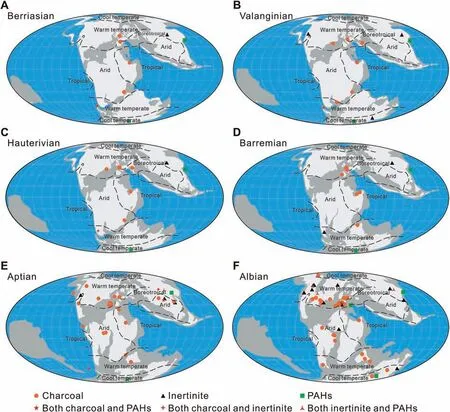
Fig.4 Paleogeographic distribution of published wildfire occurrences at the Berriasian(A),Valanginian(B),Hauterivian(C),Barremian(D),Aptian(E),and Albian(F)of the Early Cretaceous.Plate reconstructions from Scotese(2016)with paleoclimatic zones based on Boucot et al.(2013).
In addition to the factors above,taphonomic biases should be considered to explain the wildfire evidence pattern as pointed out by Abu Hamad et al.(2012).Fossil charcoals with woody tissues can be better preserved in rocks (Nichols et al., 2000; Braadbaart et al., 2009; Scott and Damblon, 2010; Caromano and Cascon, 2014).Skjemstad et al.(1996) demonstrated that in modern sediments deposited under semi-arid conditions, macroscopic charcoal can be rapidly broken into microscopic fragments that would be hardly discovered in the fieldwork.This preservational bias may cause the published Cretaceous macroscopic charcoal evidence to tend to concentrate in the warm temperate and boreotropical zones.The pyrogenic PAHs evidence allows investigating the rocks where visible charcoals were not preserved(Marynowski and Filipiak, 2007; Lu et al., 2019).However,compared with fossil charcoal evidence,the proportion of pyrogenic PAHs evidence in the published Cretaceous wildfire data is still relatively low,despite the increasing number of reported PAHs-based occurrences(e.g.,Pal et al.,2015;Tuite et al.,2016;Jiang and George, 2019; Boudinot and Sepúlveda, 2020;Synnott et al., 2021; Xu et al., 2022; Zhang et al.,2022b).Moreover, PAHs preferentially bind to organic matter (e.g., Yunker et al., 2002; Cornelissen et al.,2006), therefore, this evidence can be only applied to the organic matter-rich rocks (Abu Hamad et al.,2012; Lu et al., 2021).
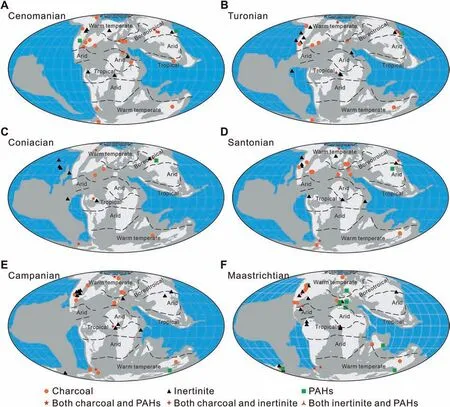
Fig.5 Paleogeographic distribution of published wildfire occurrences at the Cenomanian (A), Turonian (B), Coniacian (C), Santonian (D),Campanian (E), and Maastrichtian (F) of the Late Cretaceous.Plate reconstructions from Scotese (2016) with paleoclimatic zones based on Boucot et al.(2013).
It is worth noting that despite this compilation of 271 published Cretaceous wildfire occurrences, the sample size may still be relatively small, to interpret spatial and temporal patterns globally.From a statistical point of view, the 271 wildfire occurrences throughout the entire Cretaceous mean (statistically distributed)evidence of wildfire every~400,000 years.This implies that the database has a limited sample size to conduct meaningful causal interpretation due to the above-discussed biases (e.g., Jasper et al.,2021), at least for the Early Cretaceous (only 115 occurrences) as suggested by El Atfy et al.(2022).Overall, our published Cretaceous wildfire database may merely be a result of the above preservational and sampling biases instead of a real wildfire occurrence evolution.
4.2.Paleogeographic distribution of published Cretaceous wildfires
Wildfires are not randomly distributed on Earth,the spatial pattern of which is determined by vegetation, climate, topography, and human activity in the modern world (Krawchuk et al., 2009).Many studies indicated that in modern environmental setting, the largest wildfire frequency occurs in tropical forests and savannas(Mouillot and Field,2005;Giglio et al.,2006;Flannigan et al., 2009).Similarly, during the Early Carboniferous, high wildfire frequency considerably occurred in lower paleolatitudinal areas of the tropical climate zone(Falcon-Lang,2000;Scott and Glasspool,2006).In addition, Lu et al.(2021) reviewed that the Devonian wildfires were largely distributed in an arid climate zone,suggesting that this feature is related to the spatial evolution of limnophyte-dominant early forests on eastern Euramerica.Uhl et al.(2012)investigated the relationship between climate and the global distribution of wildfires during the Jurassic period.The study revealed that wildfires were predominantly confined to the hypothesized winter wet climate belt characterized by seasonally dry conditions, as well as the adjacent areas within the warm temperate climate belt.Belcher and Hudspith (2017)observed through simulation experiments that the flammability of different species of plants was not the same,and the spread speed and intensity of fire were also different.These spatial features of wildfire reflect that climate conditions and plant regimes can play an important role in global wildfire distribution (Scott,2000, 2010; Shukla et al., 2023).
In our study, the published Cretaceous wildfire occurrences were dominantly distributed in warm temperate and boreotropical climate zones based on the climate classification of Boucot et al.(2013)(Figs.4 and 5).This feature is characterized by the relatively high frequency of wildfires in more humid areas,which is stable throughout all 12 time-bins of the Cretaceous(Fig.2B), which is similar to the Early Carboniferous(Falcon-Lang, 2000; Scott and Glasspool, 2006).Although an arid climate would enhance fuel flammability and promote frequent wildfires, warmer and wetter conditions favouring vegetation growth could create greater fuel loads and increase fuel continuity(Denis et al.,2017;Baker,2022).Moreover,as the main wildfire ignition in geologic time, more lightning strikes under high rainfall weather can lead to an increase in wildfire frequency (Renkin and Despain,1992; Veraverbeke et al., 2017).However, in the low latitudinal tropical region, a wet climate without dry intervals may restrict the development of wildfire due to a fuel state with annually high moisture (Lu et al.,2021).Hence, the middle latitude areas with warm temperate and boreotropical climates may occur highfrequency wildfires during the Cretaceous period.
Moreover,the majority of the published Cretaceous wildfire data come from the Northern Hemisphere,showing relatively unchanged paleolatitudinal interval(30°N—60°N) throughout the 12 time-bins (Fig.3B),which may be related to the following reasons.First,the absolute area in warm temperate and boreotropical climate zones in the Northern Hemisphere was larger than that in the Southern Hemisphere (Boucot et al., 2013).Second, In the peat-forming environment, inertinites as wildfire evidence are largely known from coal seams,which were mainly distributed in the Northern Hemisphere during the Cretaceous,such as in North China (Boucot et al., 2013).As such,these factors may cause the absent nature of wildfire occurrence in the Southern Hemisphere during the Cretaceous (Brown et al., 2012).It may also result from longer and more intensive studies in Northern Hemisphere compared to the Southern Hemisphere(Brown et al., 2012; Jasper et al.,2021).
It is noteworthy that our global Cretaceous wildfire data from published literature may not represent the real spatial pattern of the Cretaceous wildfire due to a wide variety of biases, e.g., taphonomy, research efforts, and sampling factor (Abu Hamad et al., 2012;Brown et al., 2012; Lu et al., 2021).More detailed discussion sees below in Section 4.3.
4.3.Temporal trend of published Cretaceous wildfires
Changes in wildfire activity in Earth's past can be controlled by the variation in three fundamental factors over geological timescales: vegetative resources to burn(fuel),environmental conditions that promote combustion (oxygen), and ignitions (heat) (Krawchuk et al., 2009; Scott, 2000).Global pO2is hypothesized to have varied significantly throughout the Earth's history (Berner and Canfield, 1989; Lenton and Watson,2000; Bergman et al., 2004; Berner, 2006; Lenton et al., 2018).The combustion of plant material requires a minimum pO2of 12%—15%(Watson et al.,1978;Wildman et al., 2004; Belcher and McElwain, 2008),and at least 16%—18.5% for sustained burns (Belcher et al., 2010; Glasspool and Gastaldo, 2022).Higher pO2can drive prolonged periods of increased wildfire activity to produce abundant combustion by-products(Glasspool and Scott, 2010), which can enable wetter fuel to carry a fire (Watson et al., 1978; Watson and Lovelock, 2013).In the natural world, a large range of potentially flammable materials can represent fuel to burn,including exposed peats,coals,oil or gas seeps from the ground, and particularly plants (trees and grasses in shrubland ecosystems)being the major fuels(Scott, 2000).Fuel availability (load and state) provides a significant driving factor in wildfire behavior(Baker, 2022).For instance, Collinson et al.(2007)suggested that episodic rise in wildfire frequency during the Paleocene—Eocene Thermal Maximum (PETM)may be associated with fewer precipitation events,enabling increased drying of fuels for frequent fire occurrence.Denis et al.(2017) proposed that a climate-driven switch in fuel load to angiosperms from predominantly gymnosperms and ferns, was a primary driving force behind the wildfire increase across the PETM.The last basic requirement for wildfire is ignition, which can be caused by sparks from rock falls,volcanic activity, meteorite impact, and most importantly lightning (Scott, 2000; Bowman et al., 2009).The prevalence of lightning strikes would increase under higher atmospheric CO2concentrations (pCO2)that can enhance upper-tropospheric water vapor(Belcher et al.,2010; Denis et al.,2017; Zhang et al.,2022b).For instance, Belcher et al.(2010) ascribed the surge in wildfire activity during the Triassic—Jurassic transition in the Jameson Land Basin to an escalated likelihood of ignition resulting from heightened occurrences of lightning strikes,amidst the backdrop of elevated atmospheric pCO2.Furthermore,regional paleoenvironments exert a notable influence on wildfires, specifically in relation to the wet/dry depositional conditions and moisture content.Vitali et al.(2022) conducted an experimental study which revealed that oxygen concentration plays a crucial role in ignition rates and fire spread.However, high fuel moisture can restrict the spread of wildfires and prevent it.At high oxygen concentrations, fuel moisture may act as a controlling factor for fire frequency and intensity(Vitali et al.,2022).
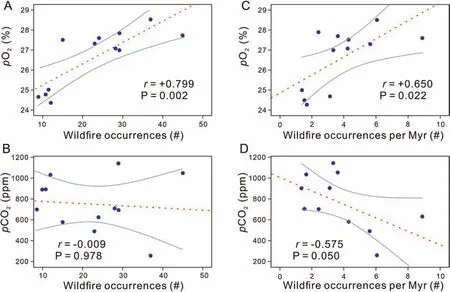
Fig.7 Cross-plots of published wildfire occurrences and representative impact factors.A) Correlation between published wildfire occurrences and pO2 (Mills et al., 2016); B) Correlation between published wildfire occurrences and pCO2 (Foster et al., 2017); C) Correlation between published wildfire occurrences per million years and pO2(Mills et al.,2016);D)Correlation between published wildfire occurrences per million years and pCO2(Foster et al.,2017).Spearman's P and r values are shown.Red lines denote the best-fit linear regression line.Gray curve lines denote the 95% confidence interval.
Our published Cretaceous wildfire data exhibited a distinctive change in wildfire activity temporally,revealing an overall rise from the Early Cretaceous to the Late Cretaceous and the highest value in the Albian.To determine whether the published Cretaceous wildfire occurrences and the related essential factors covary over the 12 time-bins,we incorporated statistical analyses to evaluate the correlations of the parameters, including pO2and lightning as ignition(Fig.6).Because the actual lightning frequency cannot be directly obtained, we used the pCO2as a proxy for lightning strikes, i.e., high pCO2would correspond to more frequent lightning (Baker, 2022).In correlation analysis, r is a statistical measure of the degree of correlation between two variables, which ranges between -1 and 1.The positive r values represent positive correlations, while the negative ones represent negative correlations.The larger absolute value of r represents a stronger relationship between the two variables.Correlation analyses show a strong positive correlation between reported wildfire occurrences and pO2(r = 0.799), and poor correlations for pCO2(r =-0.009)(Fig.7A and B).This suggests that the increase in wildfire activity during the Cretaceous period may be associated with the continuous rise in pO2.The elevated oxygen levels in the atmosphere made the fuel more susceptible to ignition, aligning with the findings proposed by numerous studies conducted in modern times and other geological epochs (Uhl and Kerp, 2003; Scott and Glasspool, 2006; Uhl et al.,2008; Glasspool and Scott, 2010, 2013; Abu Hamad et al., 2012; Brown et al., 2012; Rimmer et al.,2015; Huang and Rein, 2016).Moreover, a strong correlation was found between the variations in angiosperm diversity and changes in wildfire activity during the Cretaceous period (Fig.6A).The rise of angiosperms may have played a role in the increased occurrence of wildfire events (Denis et al., 2017).
In addition to the overall increasing trend of the published Cretaceous wildfire occurrences discussed above, the Albian—Maastrichtian showed short-term and high-magnitude oscillation in published wildfire evidence, i.e., one peak at the Albian, and lower at the Coniacian (Fig.6).However, the pO2appeared relatively stable during the Albian—Campanian(Foster et al., 2017).This may be related to the change in ignition of lightning, caused by variation in pCO2.It is also possible that researchers have shown a preference for studying early angiosperms, resulting in a significant increase in angiosperm diversity during the Albian and introducing bias.Comparing two parameters(wildfire evidence vs pCO2) over this interval, a good co-variation reveals that the elevated and degraded pCO2corresponded to higher and lower published wildfire evidence, respectively.Hence, the considerably highest reported wildfire evidence that occurred at the Albian may be linked to frequent lightning strikes caused by increased pCO2, coupled with high pO2at that time.In contrast, during the Coniacian,decreasing reported wildfire evidence may be related to low pCO2despite high pO2as ‘background’.
It should be noted that the 12 time-bins have different durations with the mean and standard deviation of 6.6±3.5 Myr instead of an even time interval(e.g., 1, 5, or 10 Myr), which can considerably affect the temporal trend of the reported wildfire evidence of the Cretaceous.To avoid the above factor,we have calculated reported wildfire evidence per million years for every time bin, which also shows an increasing trend of published wildfire data during the Cretaceous.Moreover, correlation analyses show a negative correlation between the reported wildfire evidence per million years and pCO2(r=-0.575)and strong positive correlations with pO2(r = 0.650) (Fig.7C and D).This implies that the increasing trend of reported wildfire evidence per million years from the Early Cretaceous to the Late Cretaceous is coincident with higher pO2.It should be clear that many other factors (e.g.,taphonomy, research efforts, and sampling bias) can significantly affect the temporal tread of the reported Cretaceous wildfire evidence(Abu Hamad et al.,2012;Brown et al., 2012; Lu et al.,2021).
5.Conclusions
A total of 271 reported Cretaceous wildfire occurrences around the globe were compiled from research articles, including charcoal, pyrogenic inertinite(charcoal in coal),and pyrogenic PAHs.The majority of data were collected from the warm temperate and boreotropical climatic zones in the Northern Hemisphere.An increasing trend of published wildfire occurrences is observed from the Early Cretaceous to the Late Cretaceous, which may be related to pO2.Moreover, many factors (e.g., taphonomical biases,researcher biases, and sampling biases) may have considerably influenced the preservation and recovery of wildfire evidence, leading to our dataset being not enough to reflect a real pattern of the Cretaceous wildfire evolution.42102127,42172117),the Natural Science Foundation of Shandong Province (Grant No.ZR2021QD087), the Chinese Postdoctoral Science Foundation (Grant No.2021M702019), and the SDUST Research Fund, Shandong University of Science and Technology (Grant No.2018TDJH101).
Availability of data and material
The datasets used and/or analysed during the current study are available from the corresponding author on reasonable request.
Authors'contributions
All the authors have actively participated in the preparation of the manuscript.DWL has charge of funding acquisition, project administration and supervision; WXD is responsible for data curation and manuscript preparation; ZHZ is responsible for methodology and manuscript preparation;YG is responsible for conceptualization and methodology; TTW is responsible for visualization and investigation; JCX is responsible for investigation and supervision; ACZ is responsible for software analysis and validation; CSW has charge of reviewing and edition updating.All authors read and approved the final proof.
Conflicts of interests
The authors declare that they have no known competing financial interests or personal relationships that could have appeared to influence the work reported in this paper.
Acknowledgements
We thank Zikun Jiang for her comments to improve the discussion part.We would like to thank two anonymous reviewers for their constructive comments.We thank the Deep-Time Digital Earth program(DDE) to support this work.
Funding
This study was financially supported by the National Natural Science Foundation of China(Grant Nos.
杂志排行
Journal of Palaeogeography的其它文章
- Power-law patterns in the Phanerozoic sedimentary records of carbon, oxygen, sulfur,and strontium isotopes
- The reservoir characteristics and their controlling factors of the sublacustrine fan in the Paleogene Dongying Formation, Bohai Sea,China
- Trace fossil evidences of an Early Miocene paleoseismic event and depositional regime change from the Kutch (Kachchh) Basin
- Interpreting siliciclastic sedimentation in the upper Paleozoic Mulargia-Escalaplano Basin(Sardinia, Italy): influence of tectonics on provenance
- Evolution of Cenozoic sedimentary architecture in Central and Southern South China Sea basins
- Stratigraphy of the Alveolina elliptica group from the Middle Eocene of Iran: Calibration with calcareous nannofossils biozones and description of Alveolina ozcani n.sp.
